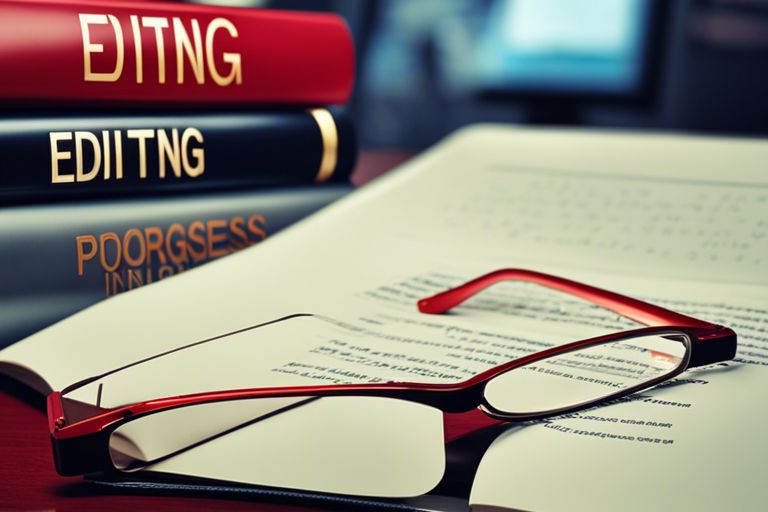Just as architects ensure a building’s structural integrity, editors play a crucial role in shaping a book’s literary quality. Understanding the editor’s contribution is vital for any aspiring author looking to navigate the publishing world successfully. This guide will probe into the various tasks and responsibilities that editors undertake to help bring a manuscript from rough draft to polished masterpiece.
Key Takeaways:
- Structural Editing: Editors provide valuable feedback on the overall structure, logic, and flow of a book, ensuring it is well-organized and engaging for readers.
- Copy Editing: They meticulously review the text for grammar, spelling, punctuation, and consistency to maintain a high level of accuracy and professionalism.
- Developmental Editing: Editors work closely with authors to refine characters, plot, and narrative style, helping to strengthen the story and make it more impactful.
- Collaborative Process: The editor-author relationship is collaborative, with editors offering suggestions and guidance while respecting the author’s creative vision and voice.
- Polishing the Final Product: Editors play a crucial role in polishing the manuscript to its final form, ensuring that the book meets publishing standards and is ready for readers to enjoy.
Understanding Different Types of Editors
Any book that goes through the publishing process requires the expertise of different types of editors. Each editor plays a crucial role in shaping the final version of the book, ensuring it meets industry standards and resonates with the target audience. Understanding the different types of editors and their specific contributions can help authors appreciate the value they bring to the table.
| Developmental Editors | Focus on the big picture elements such as plot, character development, pacing, and overall structure of the manuscript. |
| Copy Editors | Primarily concerned with grammar, punctuation, spelling, and consistency in style and formatting. |
| Proofreaders | Thoroughly review the final draft to catch any remaining errors in spelling, grammar, punctuation, and formatting. |
| Line Editors | Focus on the clarity, coherence, and flow of the writing, making adjustments to sentence structure and word choice. |
| Managing Editors | Oversee the entire editorial process, coordinate with other editors, and ensure the project stays on schedule and within budget. |
Developmental Editors
Editors specializing in developmental editing concentrate on the larger aspects of a manuscript. They work closely with authors to refine the storyline, develop characters, and enhance the overall narrative flow. Their goal is to help authors shape their raw ideas into a cohesive and engaging story that resonates with readers.
Developmental editors provide detailed feedback and suggestions for improvement, guiding authors through the revision process. They focus on strengthening the core elements of the manuscript to ensure it meets the intended objectives and captures the reader’s interest from start to finish.
Copy Editors
For copy editors, precision is paramount. They meticulously examine the text to correct grammatical errors, punctuation inconsistencies, and spelling mistakes. Copy editors also ensure that the writing adheres to the appropriate style guide, maintaining consistency in language usage and formatting throughout the manuscript.
Copy editors play a crucial role in polishing the manuscript to perfection before it goes to print. Their keen eye for detail helps eliminate distractions caused by minor errors, allowing readers to focus on the content without being hindered by grammatical or typographical issues.
When considering proofreaders, their primary focus is on eliminating any remaining errors in the manuscript before publication. They meticulously review the final draft, catching typos, spelling mistakes, punctuation errors, and formatting inconsistencies that may have been overlooked in previous rounds of editing.
Line Editors
Editors specializing in line editing focus on enhancing the prose at the sentence level. They pay attention to clarity, coherence, and style, making adjustments to improve the overall readability of the text. Line editors work on refining sentence structures, fine-tuning word choices, and ensuring a smooth flow of ideas throughout the manuscript.
Line editors aim to elevate the quality of the writing while preserving the author’s unique voice. By carefully crafting each sentence and paragraph, they help strengthen the narrative and engage readers on a deeper level.
Managing Editors
Managing editors are responsible for overseeing the entire editorial process from start to finish. They coordinate the efforts of various editors, designers, and production teams to ensure the project progresses smoothly and meets all deadlines. Managing editors also play a key role in communicating with authors, providing updates on the status of their manuscripts and addressing any concerns or feedback.
Editor’s Toolbox: Tips and Tricks for Editing Mastery
Not all editors are created equal, but having a strong toolbox of editing tips and tricks can elevate your editing game to the next level. These tools are necessary for honing your skills and ensuring that the books you work on shine.
The Importance of Style Guides
Tricks for mastering the editing craft include familiarity with style guides. These guides provide the necessary rules and conventions for consistent formatting, punctuation, and citation styles. By following a specific style guide such as APA, MLA, Chicago, or AP, editors can maintain a cohesive and professional look throughout the manuscript.
Any professional editor knows that adherence to a style guide is crucial for maintaining a consistent and polished final product. Consistency in style helps establish credibility and ensures that the reader can focus on the content without being distracted by inconsistent formatting or citations.
Common Grammar and Punctuation Pitfalls
Grammar is the foundation of good writing, and mastering common grammar and punctuation pitfalls is necessary for any editor. By understanding the rules of grammar and punctuation, editors can catch errors such as misplaced modifiers, subject-verb agreement issues, and comma splices that can detract from the clarity of the writing.
For instance, knowing when to use a semicolon instead of a comma can make a significant difference in the clarity and flow of a sentence. These nuances may seem minor, but they can have a substantial impact on the overall readability and professionalism of the text.
Enhancing Clarity and Flow in Writing
Enhancing clarity and flow in writing is a key aspect of the editing process. Editors must ensure that the text is coherent and easy to follow for the reader. Tricks for achieving this include reorganizing sentences for better flow, clarifying ambiguous phrasing, and eliminating unnecessary jargon or repetition.
Editors play a crucial role in refining the author’s message and ensuring that it is communicated effectively to the reader. By enhancing clarity and flow in writing, editors can transform a draft into a polished and engaging piece of literature that resonates with its audience.
Maintaining Consistency Throughout the Book
Book editors must focus on maintaining consistency throughout the book to provide a seamless reading experience for the audience. This includes consistency in spelling, formatting, character names, timelines, and any other recurring elements within the text. By keeping a keen eye on these details, editors can elevate the overall quality of the book.
Consistency is key in ensuring that the narrative remains cohesive and that the reader is not pulled out of the story by inconsistencies or errors. By maintaining a high level of consistency throughout the book, editors contribute to a professional and polished final product that is ready for publication.
The Step-By-Step Process of Editing a Book
To ensure a book reaches its full potential, it goes through a comprehensive editing process. Editors play a crucial role in refining and enhancing a manuscript, shaping it into a polished piece of work ready for publication. Understanding the step-by-step process of editing a book can provide valuable insight into the editor’s contribution to the final product.
| Initial Manuscript Review | In-depth Editing Phases |
Initial Manuscript Review
Process begins with an initial manuscript review where the editor assesses the overall structure, coherence, and flow of the content. This stage involves identifying areas that need improvement, such as plot holes, inconsistencies, and clarity issues. The editor also evaluates the writing style, tone, and voice to ensure they align with the intended audience and genre.
During the initial review, the editor may provide feedback on character development, pacing, and dialogue to help enhance the storytelling. This phase sets the foundation for the subsequent editing stages and serves as a roadmap for the revisions needed to elevate the manuscript to its best possible version.
In-depth Editing Phases
In-depth editing involves plunging into the details of the manuscript to address specific elements that contribute to its overall quality. This phase includes line editing, which focuses on improving sentence structure, grammar, punctuation, and word choice. Copyediting is also part of this stage, ensuring consistency in style, formatting, and language throughout the manuscript.
Manuscript undergoes multiple rounds of revisions during the in-depth editing phases, with the editor providing detailed comments and suggestions for improvement. This collaborative process between the author and editor is necessary for refining the manuscript and preparing it for the final stages of editing.
The Final Polish
Phases involve giving the manuscript a final polish to address any remaining issues and ensure it is publication-ready. This stage includes proofreading to catch any lingering typos, grammatical errors, or formatting inconsistencies. The editor focuses on fine-tuning the manuscript to perfection, paying attention to the smallest details that can impact the reader’s experience.
A well-executed final polish enhances the overall quality of the manuscript and gives it a professional finish. This last phase of editing is crucial for presenting a polished, error-free book that is ready to be shared with the world.
Key Factors to Consider When Working with an Editor
For authors venturing into the world of publishing, collaborating with an editor can be a pivotal step toward refining their manuscript. Understanding the key factors when working with an editor is crucial to ensuring a successful and harmonious partnership.
- Determining the Right Type of Editor for Your Book
- Aligning Expectations with the Editor
- Time Frame and Deadlines
- Budgeting for Editorial Services
Determining the Right Type of Editor for Your Book
With a plethora of editing services available, it is vital to identify the right type of editor for your book. Different editors specialize in various genres and editing stages. Understanding your manuscript’s needs can help you choose between developmental editors, copy editors, or proofreaders.
Collaborating with the right editor ensures that your book receives the necessary attention to detail and creative input tailored to enhance its unique elements. It’s vital to select an editor whose expertise aligns with your writing style and genre, fostering a constructive editing process.
Aligning Expectations with the Editor
An alignment of expectations between an author and an editor sets the tone for a productive editing journey. Clearly defining the scope of work, editing style preferences, communication frequency, and feedback mechanisms can prevent misunderstandings and streamline the editing process.
Authors should articulate their goals for the manuscript and discuss any specific requests or concerns with their editor. A transparent dialogue paves the way for a collaborative relationship built on mutual respect and understanding.
Perceiving the editor as a valuable partner in shaping your book can lead to a truly transformative editing experience that elevates your work to its full potential.
Pros and Cons of Different Editing Services
All editing services offer different levels of expertise and support for authors looking to improve their manuscripts. Understanding the pros and cons of each type of editing service can help you make an informed decision when choosing an editor for your book.
| Editing Service | Pros and Cons |
| Freelance Editors | Pros: Flexible schedules, personalized attention Cons: Varying quality, lack of oversight |
| In-House Editors | Pros: Professional oversight, consistency Cons: Limited availability, higher cost |
| Comprehensive Editing Packages | Pros: All-in-one service, multiple rounds of editing Cons: Higher cost, less flexibility |
| A La Carte Services | Pros: Budget-friendly, customizable Cons: Limited scope, may require multiple editors |
Freelance Editors vs. In-House Editors
Any author seeking editing services will likely come across both freelance editors and in-house editors. Freelance editors offer flexibility and personalized attention, whereas in-house editors provide professional oversight and consistency. However, freelance editors may vary in quality and have less overall oversight, while in-house editors may have limited availability and tend to cost more.
When deciding between freelance and in-house editors, it’s necessary to consider your budget, timeline, and the level of supervision you desire for your project. Ultimately, the right choice will depend on your specific needs as an author and the goals you have for your manuscript.
Comprehensive Editing Packages vs. A La Carte Services
Any author looking for editing services must also decide between comprehensive editing packages and a la carte services. Comprehensive editing packages offer all-in-one solutions and multiple rounds of editing, but they can come at a higher cost and provide less flexibility. On the other hand, a la carte services are budget-friendly and customizable, but they may have a limited scope and require working with multiple editors for different aspects of the editing process.
When considering comprehensive editing packages versus a la carte services, it’s crucial to assess the specific needs of your manuscript. If you require extensive editing and want a streamlined process, a comprehensive package may be the best choice. However, if you prefer a more tailored approach and have a clear idea of the editing services you need, opting for a la carte services could be the most suitable option.
How to Implement Editor’s Feedback Effectively
Interpreting Feedback and Critique
Keep in mind that receiving feedback and critique from an editor is an important part of the writing process. Any writer who wishes to improve their work must learn how to interpret and apply this feedback effectively. It is important to approach feedback with an open mind, viewing it as an opportunity for growth rather than a criticism of your writing abilities.
When receiving feedback, take the time to carefully consider each suggestion or critique provided by the editor. Reflect on how these suggestions align with the overall goals and message of your book. Remember that the editor’s feedback is meant to enhance your work and help you create a more polished final product.
Prioritizing Edits and Revisions
Critique often involves a multitude of suggestions for edits and revisions. Prioritizing these changes can seem overwhelming, but it is important to focus on the most impactful suggestions first. Consider the editor’s expertise and perspective when deciding which edits to prioritize. Think about the suggestions that will have the most significant impact on improving the clarity, flow, and overall quality of your book.
Prioritizing edits and revisions also involves being willing to make tough decisions about what to keep, revise, or cut from your manuscript. Remember that the ultimate goal is to create the best possible version of your book, and this may require making some difficult choices along the way.
Maintaining Your Voice While Accepting Changes
When prioritizing edits and revisions, it is crucial to maintain your unique voice as a writer. Critique from an editor should not overshadow your individual style and tone. While implementing changes, ensure that your voice remains authentic and consistent throughout the manuscript.
It is important to strike a balance between accepting feedback and preserving your creative vision. By staying true to your voice while incorporating edits, you can ensure that the final product is a harmonious blend of your original intentions and the editor’s suggestions.
Collaborating for the Best Outcome
Interpreting and implementing feedback is not a solitary endeavor; it is a collaborative process between writer and editor. Collaborating effectively with your editor can lead to a stronger, more cohesive final product. This partnership requires open communication, mutual respect, and a shared commitment to creating the best possible book.
Summing up
To wrap up, an editor plays a crucial role in the publishing process by polishing a manuscript and ensuring it is refined, coherent, and engaging for readers. Editors provide valuable feedback, make insightful suggestions, and meticulously review the content to enhance its quality and readability. Their expertise and attention to detail help authors bring their vision to life and produce a book that meets publishing standards.
FAQs
A: An editor plays a crucial role in the book publishing process. They review manuscripts, provide feedback to authors, suggest revisions, correct errors in grammar and punctuation, and ensure the overall quality and coherence of the book.
A: There are several types of editors, including developmental editors who focus on the structure and content of a book, copy editors who check for grammar and consistency, line editors who work on sentence structure and flow, and proofreaders who review the final draft for errors.
A: Editors help improve the clarity of a book by making sure the language is concise and easy to understand. They also ensure that the ideas are presented logically and cohesively, making the book more accessible to readers.
A: Editors work closely with authors to understand their unique voice and style. They make suggestions to enhance the author’s writing while preserving their original voice, ensuring that the book reflects the author’s intentions and personality.
A: Hiring a professional editor is necessary for ensuring the quality and professionalism of a book. Editors bring expertise, objectivity, and a fresh perspective to the book, helping authors polish their work and increase its chances of success in the competitive publishing industry.




